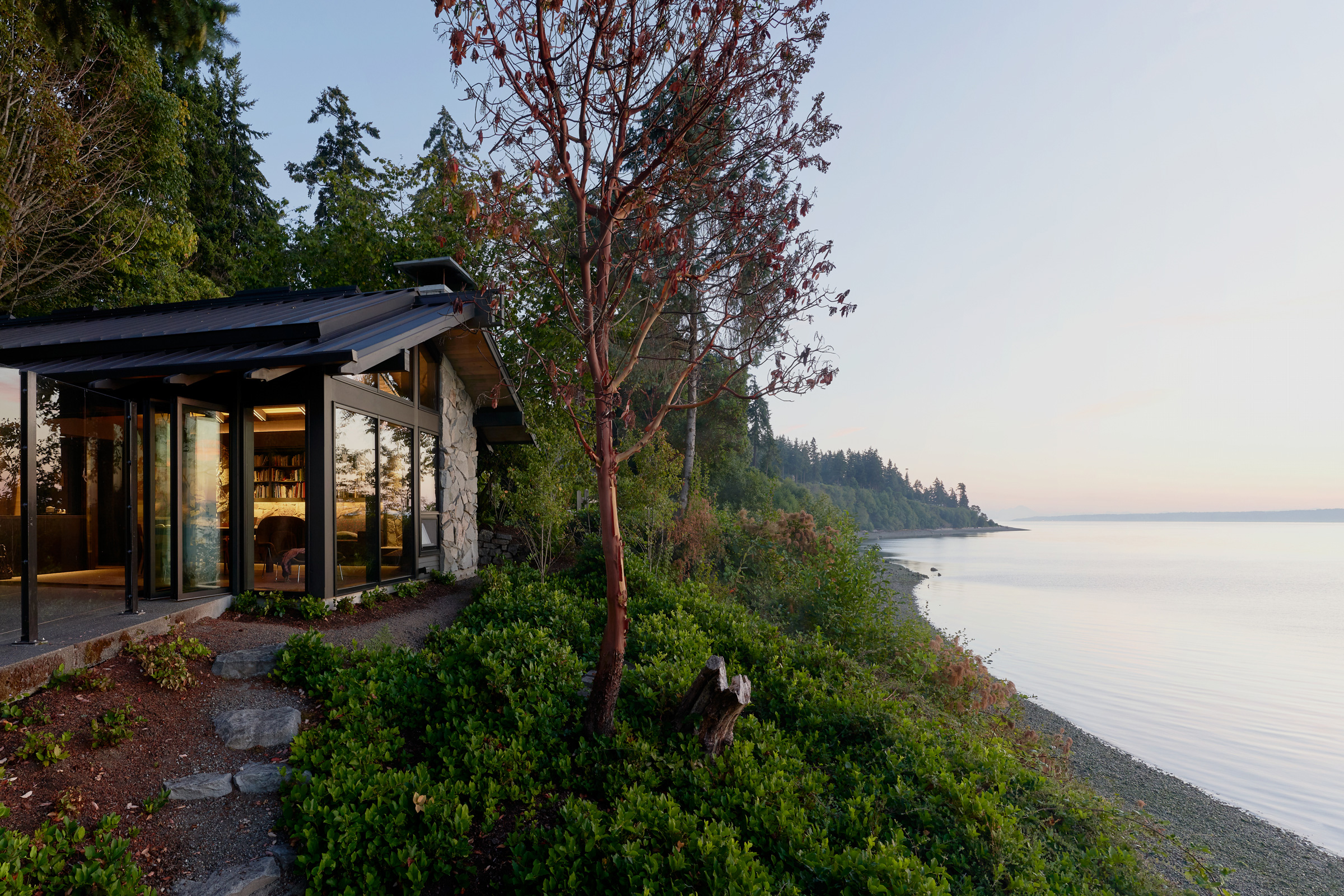Story at a glance:
- Switching to energy-efficient appliances like LED light fixtures, sealing air leaks, and upgrading your insulation will reduce your household’s carbon emissions.
- Installing low-flow and WaterSense certified fixtures, faucets, and showerheads can help reduce your home’s water usage.
It’s become increasingly clear that the extraction and consumption of fossil fuels is the largest contributing factor to climate change. And while the individual is often encouraged to make more sustainable decisions to do their part, the reality is that, since 1988, just 100 companies have been the source of more than 70% of the world’s greenhouse gas emissions, according to a report published by the Carbon Disclosure Project in collaboration with the Climate Accountability Institute.
Of course that doesn’t mean we don’t have any responsibility when it comes to reducing emissions and addressing pollution, especially when it comes to household use of water and electricity. These are 50 ways that you can make your home more sustainable.
50 Ways to Make Your Home More Sustainable
1. Upgrade Your Insulation

Greenfiber’s wood-fiber insulation starts as a plant material, is made into paper, and reused as insulation. Photo courtesy of Greenfiber
Typically new homes are insulated with fiberglass insulation, polyurethane foam insulation, or a mix of both—and while these both have high R-values (2.2 to 2.7 per inch, and 6.5 to 6.7 per inch, respectively), they aren’t particularly sustainable in that they often contain harmful chemicals that are hazardous to human health.
Fortunately, there are a number of natural insulation alternatives that exist, such as wood-fiber cellulose, Rockwool, hemp, sheep’s wool, and even straw. Depending on the thickness of the insulating layer, many of these options offer similar or better thermal retention than traditional fiberglass insulation.
Wood-fiber cellulose insulation—such as that produced by Greenfiber—has an R-value between 3.2 to 3.8 per inch, while sheep’s wool insulation has an R-value of 3.6 to 4.3 per inch. That said, few insulation materials rival the R-value of traditional polyurethane foam, but ongoing tests are being conducted on plant-based polyurethane foam insulation, which could yield similar thermal retention properties.
Ultimately upgrading your insulation reduces the amount of heat gained and lost throughout the year, which subsequently minimizes the energy spent—and emissions produced—on cooling and heating your home.
2. Seal Air Leaks
Of course upgrading your home’s insulation is only half the picture when it comes to improving energy efficiency and interior temperature regulation; the other half is sealing up any areas where air can leak out or in.
Air leaks account for approximately 25 to 40% of the energy used to cool and heat a home, according to Energy Star. Even worse, air leaks can also significantly reduce the effectiveness of your home’s other energy-saving features, leading to the waste of energy, time, and money.
Taking care to verify that all seals around doors, windows, and other potential openings are airtight—and resealing those that aren’t—will drastically minimize the amount of heat gained during the summer and heat lost during the winter months.
3. Upgrade Your Windows

This Maya-inspired house in Tulum makes use of energy-efficient windows that let in natural light without admitting excess solar heat. Photo by César Bejar
On average, heat lost and gained through windows accounts for anywhere from 25 to 30% of residential HVAC energy usage—but drafty or older windows can result in an even higher percentage of energy waste. To reduce the amount of energy lost through your household’s windows, replace existing windows with energy-efficient alternatives, or windows with an ENERGY STAR label.
Generally speaking, energy-efficient windows feature a frame with high thermal resistance (such as wood), high-quality weather-stripping for improved sealing, and either dual- or triple-paned glass that contains inert argon gas between the layers. By adding a laminate, coating, glaze, or temper to the glass, energy-efficient windows can offer additional protection against UV rays and solar heat gain—all without limiting natural daylight admittance.
4. Install Blinds and/or Curtains
To minimize your windows’ solar heat gain and loss even further, install blinds and/or curtains to help reflect and retain heat throughout the year.
During the summer curtains can help reduce heat gain by roughly 33%, while blinds can help reduce indoor heat gain by as much as 40%. In winter drawing your curtains at dusk can help reduce heat loss by approximately 10%, and blinds also offer a marginal degree of protection against heat loss.
5. Invest in Light Shelves
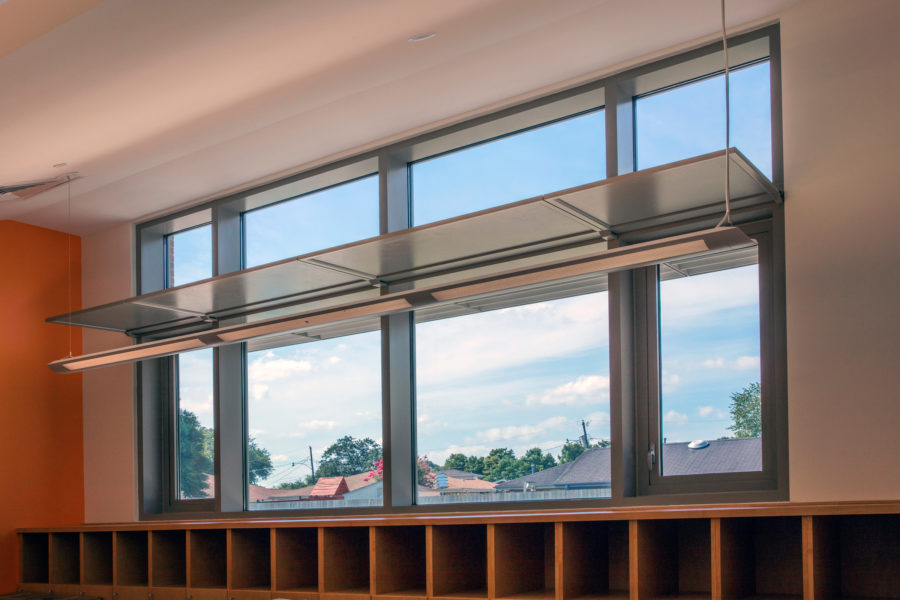
A light shelf is a way to reduce dependence on artificial lighting in interior spaces. Photo courtesy of Kawneer
Another easy way to make the most out of natural sunlight is by installing light shelves on your windows. These horizontal shelves are a type of passive daylighting device typically affixed above eye level, about two-thirds to three-fourths of the way up a window. They feature a highly reflective upper surface that reflects light up onto the ceiling so that it washes further into a room.
Historically light shelves have been implemented mainly in commercial and office spaces, but they can be used residentially as well—especially when combined with clerestory windows.
6. Select Energy-Efficient Appliances

All of the appliances in this kitchen were selected for their ENERGY STAR rating. Photo by Krista Jahnke Photography
Another simple way to improve your home’s overall sustainability is by investing in energy-efficient appliances. Nowadays you can find an energy-efficient version of just about any major appliance—be it a refrigerator, oven, dishwasher, stove, washing machine, dryer, etc.
If you’re having trouble determining whether an appliance is efficient, check to see if it bears an ENERGY STAR label. If it does, the appliance has been deemed energy-efficient according to guidelines set by the EPA or the DOE. In most cases ENERGY STAR appliances significantly exceed federal standards for both quality and efficiency, which means they’re likely to last longer, too.
7. Install LED Lights & Fixtures

RGBW Tape Light with Spektrum+ Control GT Extrusion is seen below the fireplace pedestal. Photo courtesy of American Lighting
Due to the fact that they produce heat in addition to light, traditional fluorescent and incandescent light bulbs are largely inefficient. LEDs, on the other hand, generate almost no heat and use anywhere from 75 to 90% less energy, according to the DOE.
LEDs are also significantly more durable than fluorescent and incandescent lightbulbs because they lack a filament (the part that burns out over time); as a result LEDs can be expected to last approximately 20 times longer than other lighting options, which in turn means they do not need to be replaced as often and therefore contribute less waste to landfills.
Artistic pathway LED lighting on the foyer floor at the house pictured comes in the form of 3000K Trulux Canvas LED sheets with backlighting quartz from American Lighting. Developed for backlighting semi-transparent architectural features on floors, walls, and even countertops, Trulux Canvas LED Sheets are available in 12-by-24-inch sheets that can be cut to size at the jobsite for a perfect fit.
8. Use a Programmable or Smart Thermostat
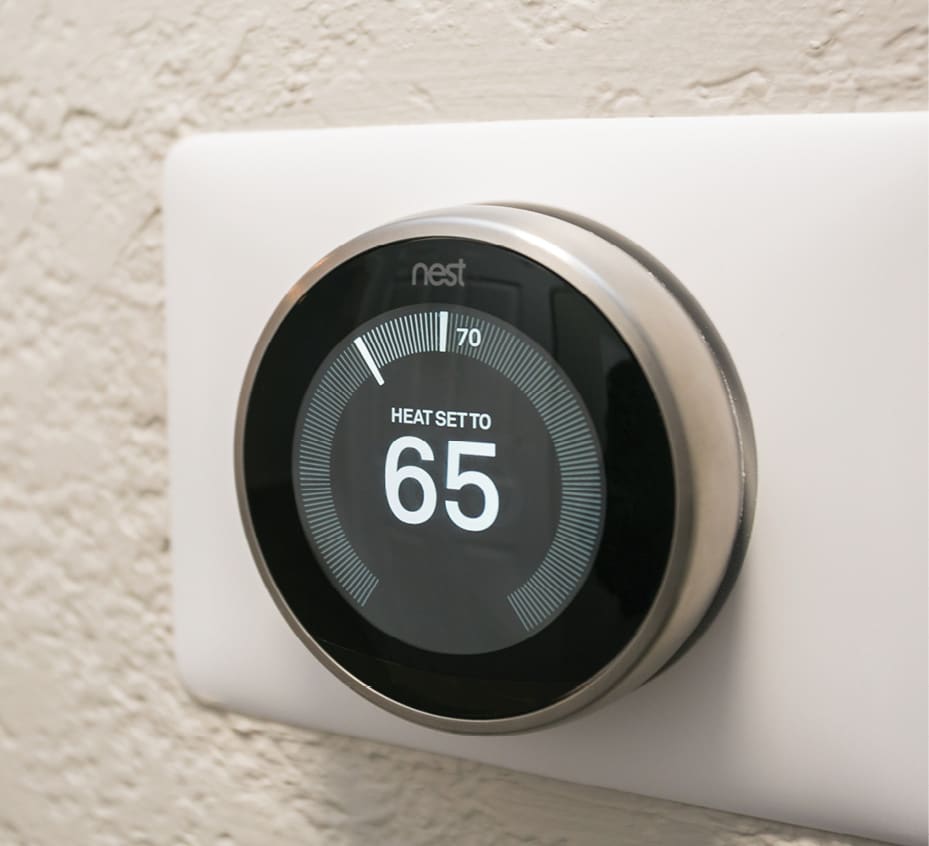
A smart thermostat—like this one offered by Nest—can help households reduce heating and cooling expenses by approximately 12%. Photo courtesy of Nest
If you don’t work from home or your house is empty much of the day, chances are you don’t need to run the heat or air conditioning during hours you’re away. This is where having a programmable thermostat comes in handy, as it can be set to follow a schedule instead of running constantly.
Smart thermostats like those offered by Nest can even take things a step further by using machine-learning to constantly optimize your household’s heating and cooling strategies.
On average programmable thermostats save homeowners up to 10% on their energy costs, whereas smart thermostats can help save approximately 12% on heating and cooling expenses.
9. Unplug Devices & Upgrade Your Power Strips
While it’s true that some devices, such as computer modems and televisions, need to be plugged in constantly, most smaller devices and appliances do not—and leaving them plugged in when they aren’t in use wastes energy. It’s estimated that approximately 40% of a device’s annual energy use is wasted on standby power, or power consumed while the device is plugged in but not in use.
Getting in the habit of unplugging devices—your phone charger, laptop, toaster, electric kettle, etc.—when you’re not using them will help save your household money and reduce its overall carbon footprint.
Alternatively, if you don’t want to deal with the inconvenience of constantly unplugging and plugging-in appliances, invest in smart power strips that feature outlets which automatically shut off electricity to things that aren’t being used.
10. Install (and Use) Ceiling Fans

Ceiling fans can help regulate interior temperatures using far less power than traditional air conditioning units. Photo courtesy of Hunter Fan
While it may not come as a surprise that ceiling fans are more efficient than traditional air conditioning systems, you might be surprised at just how much more efficient they are. On average ceiling fans use 99% less energy than central AC systems—and in most cases high-quality ceiling fans are capable of effectively regulating interior temperatures as long as outdoor temps are below 95°F.
Ceiling fans use 99% less energy than central AC systems.
Most ceiling fans can also be reversed so that instead of pushing air downward, they pull air upward, which can aid in dispersing heat (which rises) more evenly throughout a room during the winter.
11. Service Boilers & HVAC Systems Regularly
If you rely on an HVAC system or boiler for heating and hot water, it’s important to have it serviced regularly to ensure it is operating at peak efficiency. HVAC systems, for example, need to have their filters replaced on a routine basis lest they become clogged, which in turn forces the system to work harder, drawing more energy than is necessary.
Similarly, gas-fired, hydrogen, and biomass boilers need to be serviced at regular intervals, as certain maintenance issues can cause them to burn more fuel than is necessary to properly heat your home or water, resulting in higher energy bills and greater emissions.
12. Switch to Hydronic Radiant Heating
That said, you could also ditch the HVAC altogether in favor of an underfloor hydronic radiant heating system, which uses water instead of air for heating purposes.
Due to the fact that water has the capacity to transport energy 3,500 times greater than air, radiant heating systems are considered one of the most efficient ways to heat a home. On average they are at least 20 to 25% more energy-efficient than conventional forced-air heating systems.
Unlike centralized HVAC units, hydronic radiant heating is installed as separate zones. “This means occupants have a separate thermostat for each radiant-heated space,” Kim Bliss, content development manager at Uponor, previously told gb&d. “Not only does this provide custom comfort control when people are in a space, it also makes the system even more energy-efficient because people can keep the heat low in spaces that are not in use.”
13. Install Energy Recovery Ventilators
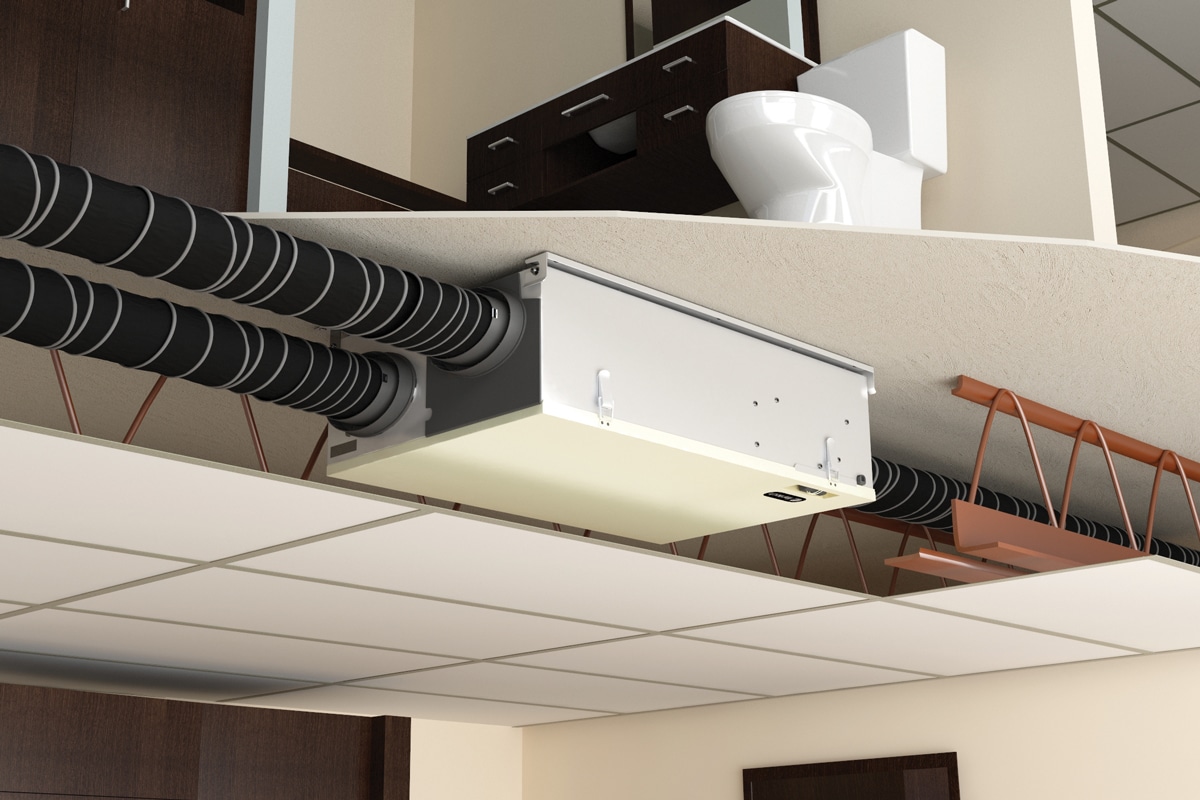
ERVs help reduce heating and cooling loads by recovering heat from incoming and outgoing air. Photo courtesy of Fantech
If you aren’t able—or don’t think it’s feasible—to switch over to a radiant heating system, you can still save energy on heating and cooling by installing energy recovery ventilators (ERVs).
Designed to work in tandem with an HVAC system, ERVs pull fresh air in from outside and expel stale interior air back outside via ducts or vents. During warmer months an ERV unit will recover heat from the incoming air and direct it back outside; in winter an ERV recovers heat from the outgoing air and reuses it to help warm the incoming air.
Ultimately this aids in improving indoor air quality by flushing out pollutants as well as reducing the energy needed to heat and cool the air by approximately 50%.
14. Install a Low-Energy Exhaust Fan
Generally speaking, all household’s feature at least one exhaust fan, as indoor bathrooms require them to help remove humid air produced while bathing or showering—but exhaust fans can also be installed in other rooms, as they aid in ventilation and help expel pollutants outside, improving your home’s overall air quality. It should be noted, however, that not all exhaust fans are created equally, especially when it comes to efficiency.
Fortunately there is a wide variety of ENERGY STAR certified options on the market, all of which use significantly less electricity (typically at least 50% less), make use of humidity sensors to bolster performance, and run much quieter than their high-energy counterparts.
15. Choose Sustainable Building Materials

Lustrous flooring made largely of cork creates a cozy feeling. The cork is not only a more sustainable option; it is a natural sound insulator. Photo by Ivo Tavares Studio
While it may be too late to have a say on the types of materials used to build your home, you do have control over what materials are used in remodeling, renovating, or any other household projects.
In terms of sustainable building materials, natural materials like cork, timber, tile, and stone are ideal due to their low embodied carbon, but priority should really be given to any materials that are free of Red List ingredients, or those chemicals considered hazardous by the International Living Future Institute.
Perhaps even more important, however, is using recycled materials—or at the very least, products containing recycled materials—wherever possible in your home improvement projects. Reclaimed wood, for instance, has a multitude of uses both inside and outside the home, while construction-grade bricks, cement-blocks, and the like can be incorporated into outdoor patios or firepits.
16. Install Sustainable Flooring
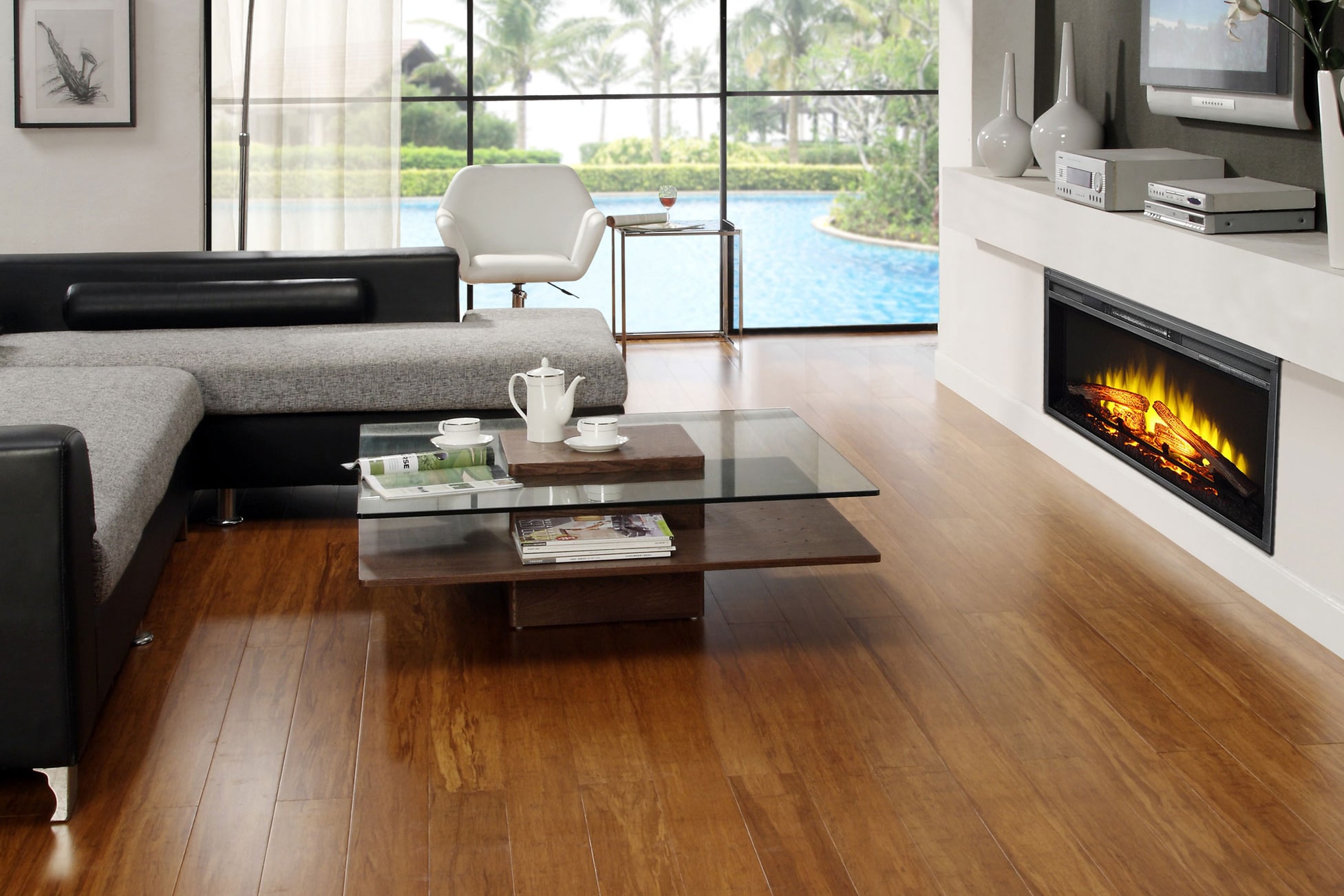
Bamboo flooring is more sustainable than hardwood flooring and can be made to look nearly identical. Photo courtesy of dasso USA
If it’s time to replace your household’s—or at least a couple rooms’—existing flooring, you’re in a perfect position to improve your home’s sustainability, as there are plenty of environmentally friendly flooring options on the market.
Hardwood flooring, for example, is an incredibly popular and versatile flooring option that, when bought from an FSC-certified manufacturer, is relatively low impact in that it is a renewable material that sequesters carbon throughout its entire life cycle. Hardwood flooring is also quite durable and can last for anywhere from 50 to 100 years, provided it is regularly refinished.
There are, however, even more sustainable flooring options, like bamboo. Unlike hardwoods, which typically require 20 years before they can be harvested, bamboo can be harvested every three to five years without damaging the base of the plant itself, meaning each bamboo culm can be harvested multiple times throughout its life. Once processed, bamboo flooring looks very similar to hardwood flooring and possesses many of the same desirable qualities, while also being highly water-resistant and hypoallergenic.
Alternatively, you could opt for inorganic flooring, such as stone or porcelain tile, both of which possess excellent durability and are highly water-resistant, making them ideal for use in bathrooms. Porcelain tile flooring can also incorporate recycled waste materials during the production process, increasing its sustainability further.
17. Protect Your Home’s Exterior
At the end of the day a sustainable home is a long-lasting home—and one of the most important factors when it comes to ensuring a home’s longevity is the type of material used to protect its exterior. In our modern world vinyl siding is one of the most popular siding options, but seeing as it’s made from plastic, it isn’t particularly environmentally friendly.
Timber siding, however, is a sustainable option and offers similar protection compared to vinyl, provided it is properly maintained. Engineered or thermally modified wood siding is even better and may last as long as or longer than vinyl siding (60+ years), especially in colder climates—and wood offers improved insulation over vinyl siding, too.
Stone cladding is also an excellent choice when it comes to protecting your home, as it is incredibly durable, weather-resistant, and has a 100+ year life expectancy.
Whatever siding option you decide on, take care to ensure it is installed correctly and maintained properly to prevent moisture from accumulating behind it. If left unchecked excess moisture can lead to fungus, mold, mildew, and eventually rot, which can in turn jeopardize the structural integrity of the home itself.
18. Install a Cool Roof

GAF’s TPO roofing (thermoplastic polyolefin roofing) takes the cake for environmental performance, as the white reflective surface results in drastically lower cooling costs. Photo courtesy of GAF
If you live in a warmer region that receives a lot of sunlight throughout the year, your roof may be working against you when trying to keep the interior cool. Traditional dark-colored roofs can reach temperatures of up to 150°F or more during the summer, forcing your air conditioning to work over time.
Cool roofs, on the other hand, are much lighter in color (typically white) and implement coatings that reflect sunlight rather than absorb it. “Just as wearing light-colored clothing can help keep a person cool on a sunny day, cool roofs use solar-reflective surfaces to maintain lower roof temperatures,” Lon Bauer, product development manager at APV Engineered Coatings, previously wrote for gb&dPRO.
Any heat that is absorbed is effectively emitted back into the air, rather than the building itself. On average cool roofs stay at least 50 degrees cooler than dark roofs under the same conditions, according to the DOE.
19. Apply UV-Reflective Coatings

Westcoat manufactures systems for UV-resistant and waterproof decking on balconies, patios, porches, and around pools. Photo courtesy of Westcoat
That said, UV-reflective coatings aren’t limited solely to rooftops; they can also be applied to decking, driveways, patios, balconies, and even exterior walls. Westcoat and APV Engineered Coatings, for example, both offer a range of solar-reflective coatings that can be applied overtop concrete and wooden surfaces without issue.
These coatings are especially useful in prolonging the life of wooden features like porches and decks, as wood deteriorates faster when frequently exposed to UV rays. Both company’s UV-reflective coatings also offer a not-insignificant level of water-resistance, helping to prevent early on-set rotting and decay.
“Such high-performance coatings can also resist buildup of dirt, mold, and mildew—keeping them cleaner, reducing the amount of maintenance needed, and allowing the reflective properties to be sustained for longer,” Bauer previously wrote for gb&dPRO.
20. Air Seal Your Attic
If you have an attic in your home, chances are you’re losing energy through it. It’s estimated approximately 45% of a household’s energy is lost through the attic, specifically through improperly sealed areas where fixtures penetrate the attic’s floor or ceiling.
By hiring a professional to seal your attic (typically using either caulk or spray foam), you’ll ensure there are no leaks around light fixtures, pipes, wiring, outlets, vents, and chimneys where air—and subsequently energy—can escape.
When combined with proper insulation, attic air sealing makes it much easier to retain warm air during the winter and cool air during the summer, reducing the need for mechanical heating and cooling.
21. Opt for a Green Roof
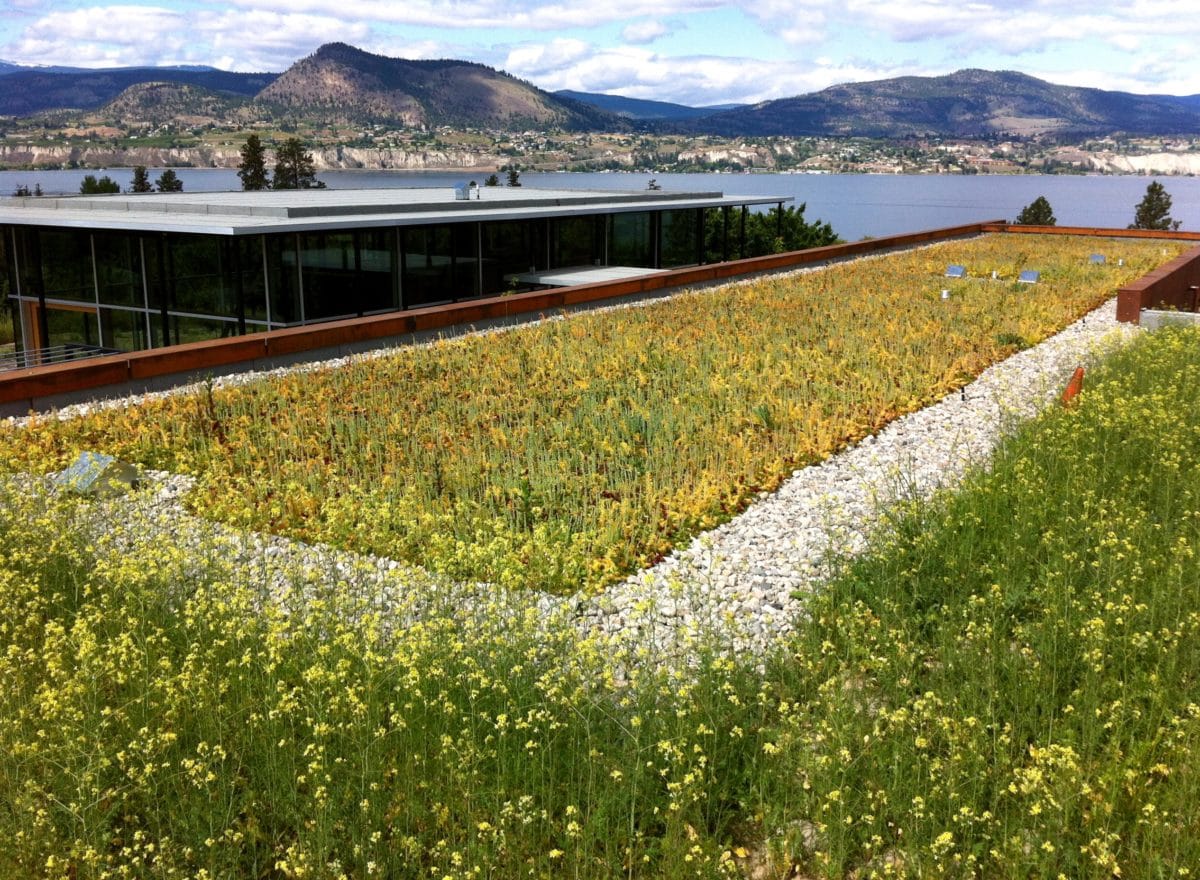
This green roof by Architek is seeded with indigenous plant species that provide homes and sustenance for crucial pollinators like bees and butterflies. Photo by Brett Ryan Studios
Depending on the pitch and slope of your home’s existing roof system, you may be able to install a green roof. Generally speaking green roofs are made up of seven layers: structural support, a vapor barrier, thermal insulation, root barrier, drainage layer, filter membrane, and a growing medium (e.g. soil). Indigenous plant species are then planted in the growing medium and allowed to flourish, similar to a yard or garden.
Green roofs are highly sustainable in that they are capable of reducing a roof’s stormwater runoff rate by up to 65%, promote biodiversity and ecosystem conservation, and aid in removing pollutants from the air.
Green roofs also serve as passive cooling devices; on average green roofs are 30 to 40% cooler than conventional roof surfaces and reduce heat flux from the roof to the building by as much as 72%.
22. Use Low-VOC Paint
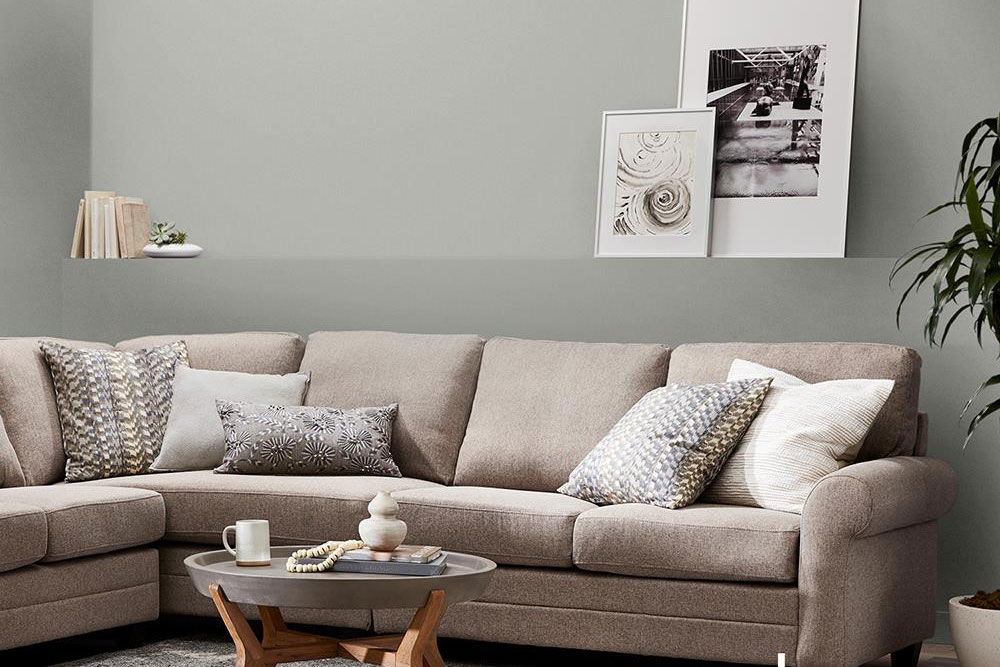
Valspar’s Signature paint is one of this brand’s low/no VOC offerings. Photo courtesy of Valspar
Utilizing paints that are low in volatile organic compounds (VOCs) is another way to enhance both the sustainability of your home and the quality of the air you breathe. Traditional oil- or solvent-based paint frequently contains VOCs that, over time, release dangerous chemicals into the air, increasing the risk of residents developing debilitating respiratory conditions and even some cancers.
Low VOC paints, on the other hand, are often water-based and contain little to no hazardous compounds, which means they also emit fewer fumes when drying.
23. Install Solar Panels
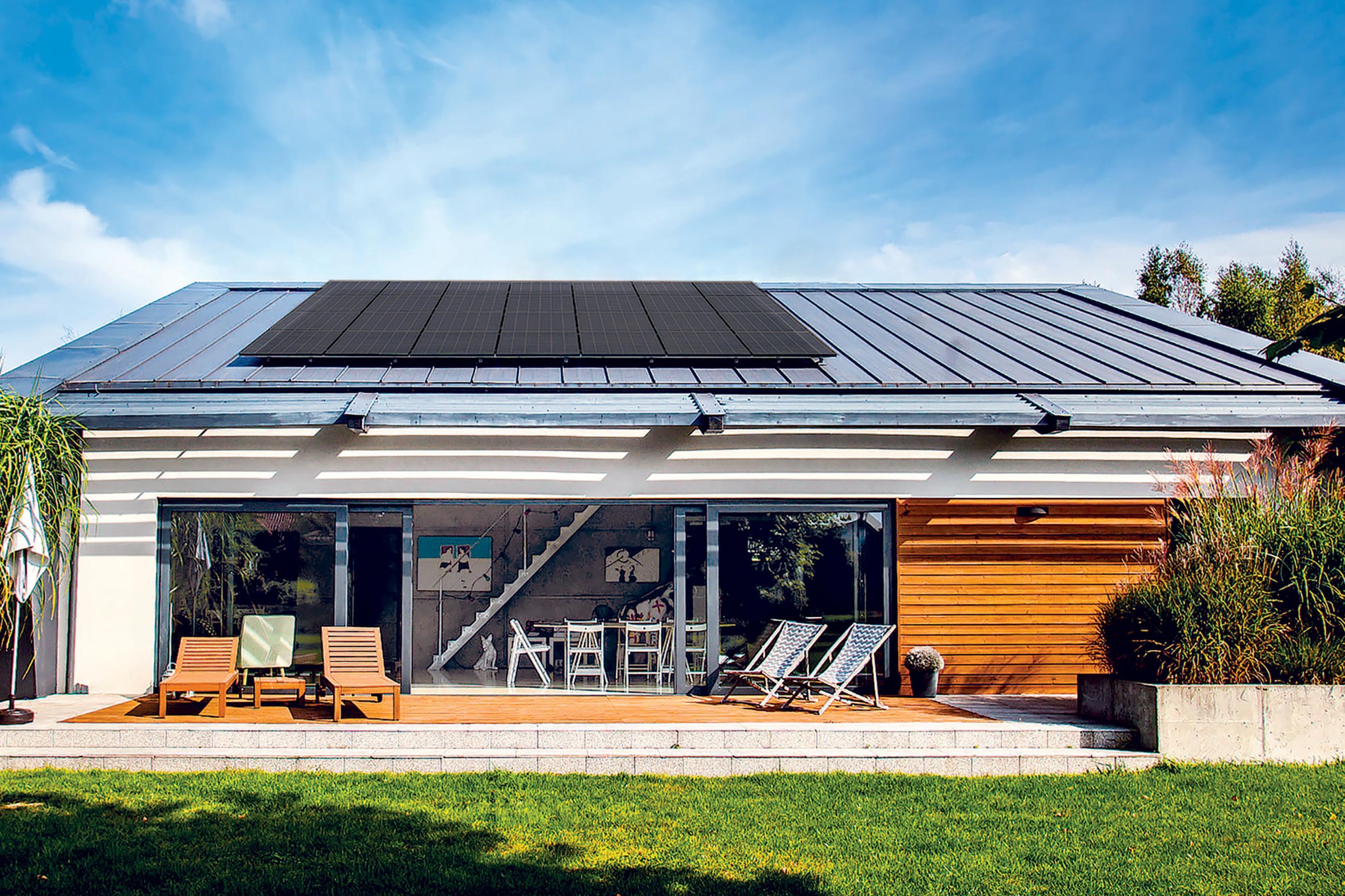
Solar panels can help households reduce their dependency on predatory energy providers and save an average of $1,500 per year. Photo courtesy of Q Cells
Onsite renewable energy production is one of the hallmarks of a truly sustainable house, and solar panels are the easiest way to achieve that goal. As long as they are strategically placed and angled—and climate conditions permit—solar panels can feasibly produce energy for all or a portion of the year in a variety of geographic regions, even those in northern climates.
On average residential solar panel systems save households approximately $1,500 a year on electricity bills and produce 12 times fewer CO2 emissions than natural gas. Depending on how efficient your solar panels are and the amount of energy they are capable of generating, your household may even be able to sell excess electricity back to your local energy provider for a profit.
In the US residential solar energy assistance programs and incentives (e.g. tax credits) exist at both the state and federal levels, making it that much easier for households to afford and install solar panels. A full guide to energy-related federal financial assistance programs can be found on the DOE’s website.
24. Install a Low-Flow Toilet
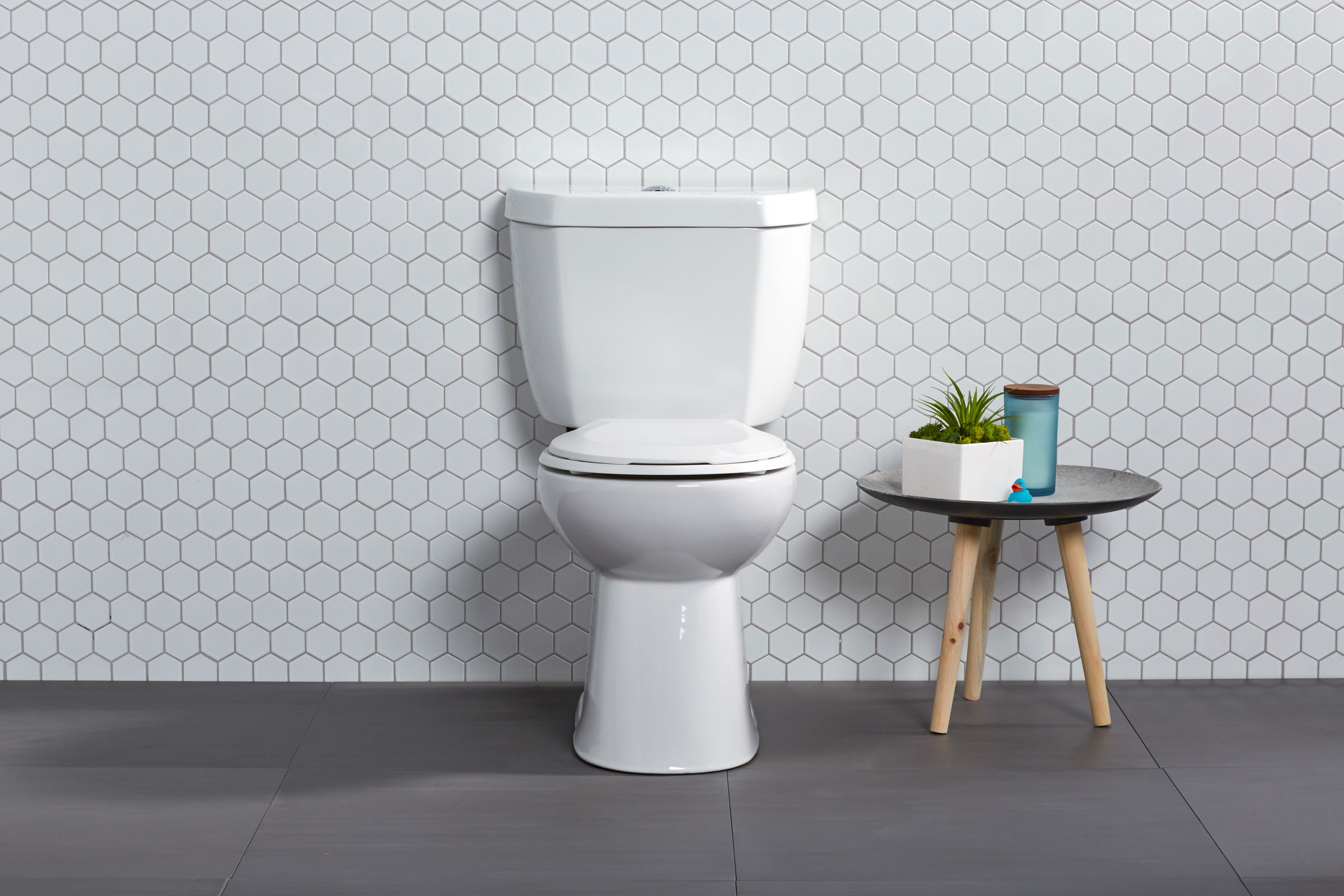
The most efficient low-flow toilets use less than 1.28 gallons of water per flush. Niagara toilet. Photo courtesy of Niagara
Estimates suggest that roughly 27% of a household’s daily water consumption is the result of flushing the toilet, according to the EPA. To help your household conserve water, consider replacing your toilet with a low-flow alternative, such as those produced by Niagara, a leading manufacturer of high-performance bathroom fixtures.
In compliance with plumbing standards set by the US government, low-flow toilets use no more than 1.6 gallons of water to flush. If your home was constructed after 1994, chances are you already have one installed. If you live in an older house with a toilet that was constructed before 1994, however, you may be using up to 7 gallons of water per flush, meaning an upgrade is in order.
Of course, not all low-flow toilets are as effective as others. If you’re serious about saving water, select a highly efficient toilet that consumes no more than 1.28 gallons per flush. Ultra-efficient low-flow toilets can be recognized by their WaterSense certification, which denotes that they have successfully completed stringent independent laboratory testing with regard to performance and efficiency.
25. Invest in a Low-Flow Showerhead
While you’re at it, think about replacing your current showerhead with a low-flow version.
Standard showerheads typically use 2.5 gallons of water per minute, but you may be consuming far more depending on the kind of shower system you have installed (such as one with several showerheads).
Showerheads with the WaterSense low-flow seal of approval, however, use no more than 2 gallons of water per minute. Once installed it’s estimated that these fixtures can help household’s save 2,700 gallons annually. Furthermore, a low-flow showerhead will help reduce demand on your water heater, saving you money on energy bills.
26. Install Low-Flow Faucets
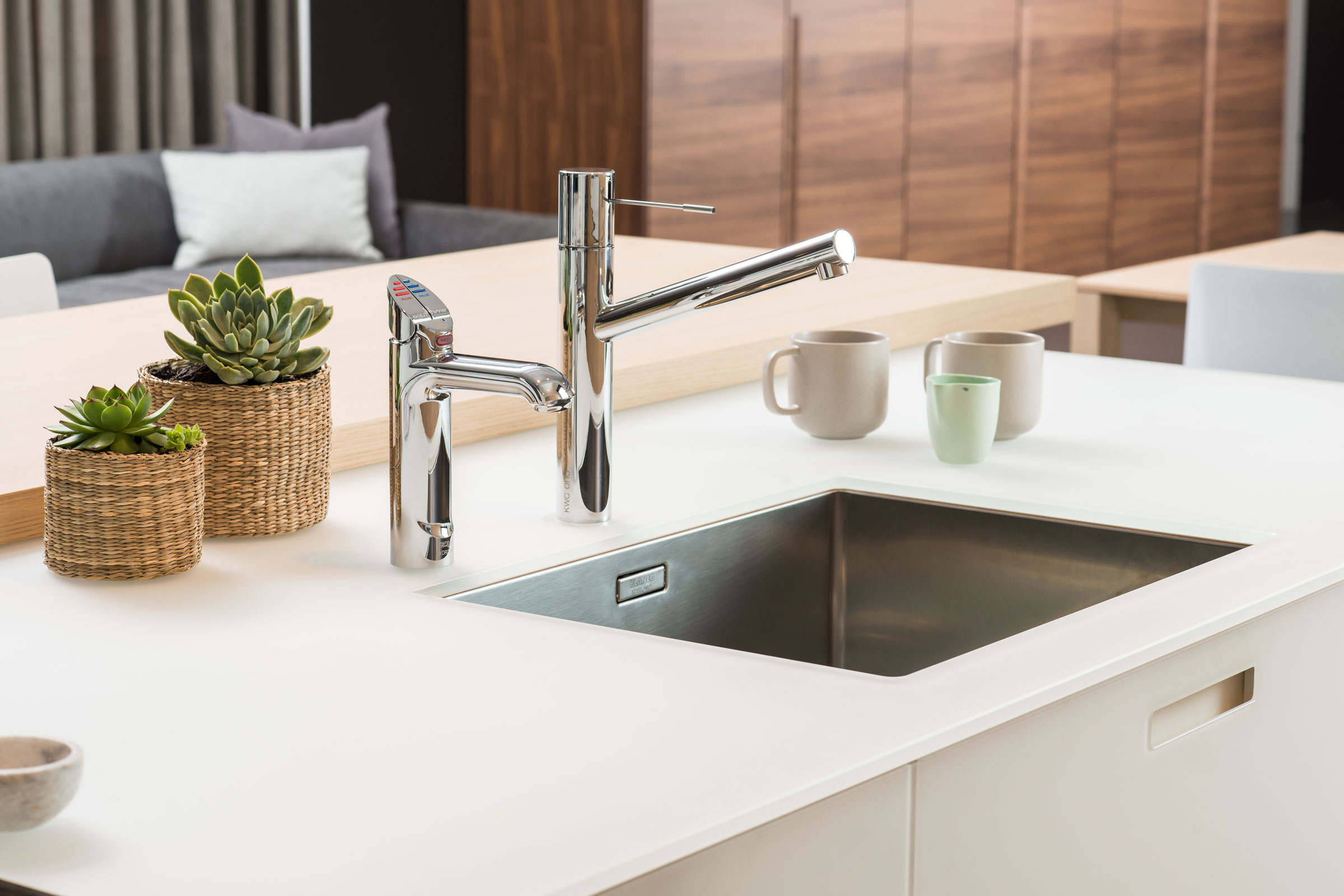
Switching to a low-flow faucet can reduce water consumption by 30%. Photo by Guy Davies
Although sink faucets normally consume the least water of all household fixtures, there is still room for improvement in terms of water usage. Older faucets often flow at a rate of 1.5 to 2.2 gallons per minute, which is generally more water than most sinks require.
There are, however, low-flow faucets that flow at a rate below 1.5 gallons per minute, which can reduce your sinks’ water flow by at least 30% without sacrificing performance in the process. In doing so you’ll save money and reduce water heater usage by a significant margin.
27. Fix Leaky Plumbing
Installing low-flow fixtures isn’t of much use if you’re wasting water via leaky plumbing. It’s estimated that in the United States alone more than 2 trillion gallons of clean water is lost to leaky faucets and pipes a year—and a pipe that leaks at a rate of one drip per second, for example, can waste more than 3,000 gallons a year, resulting in higher utility bills.
Regularly inspecting plumbing, pipes, fixtures, and faucets for leaks—and fixing those you find—is a simple way to save both water and money.
28. Turn Down Your Water Heater
Typically water heaters are set to 140℉ per factory specifications—and if you think that seems a bit extreme, you’re right. Not only is this hotter than necessary for most household applications, it also produces significant standby heat loss—or heat that is lost from the heater to surrounding areas.
Turning your water heater down to 120℉ can lead to energy savings between 4 and 22%, or as much as $400 annually, according to the DOE. This also decreases the likelihood of accidental scalding and won’t interfere with getting your shower, dishwasher, or any other appliance hot enough.
29. Install a Tankless Water Heater
While the true efficiency of a tankless water heater ultimately depends on how much hot water your household uses in a day, there’s no doubt tankless water heaters are more efficient than—and result in fewer emissions compared to—conventional storage tank heaters.
A smaller household, for instance, or one that uses less than 41 gallons of hot water a day, can expect to use 24 to 34% less energy by switching to a tankless water heater. Larger households that use closer to 86 gallons of hot water a day, on the other hand, may only use 8 to 14% less energy—which still helps save money and energy in the long run.
30. Wash Clothes With Cold Water
Washing your clothes with cold water is significantly more efficient than washing with warm or hot water. In fact, it’s estimated that washing with cold water is 90% more efficient than washing with hot water, as most of the machine’s energy is spent on heating water. What’s more, cold water is just as effective at cleaning clothes as hot water and is actually better for removing stains.
Washing your clothes in cold water also helps them last longer, thereby resulting in reduced landfill waste.
31. Collect, Store, and Reuse Rainwater
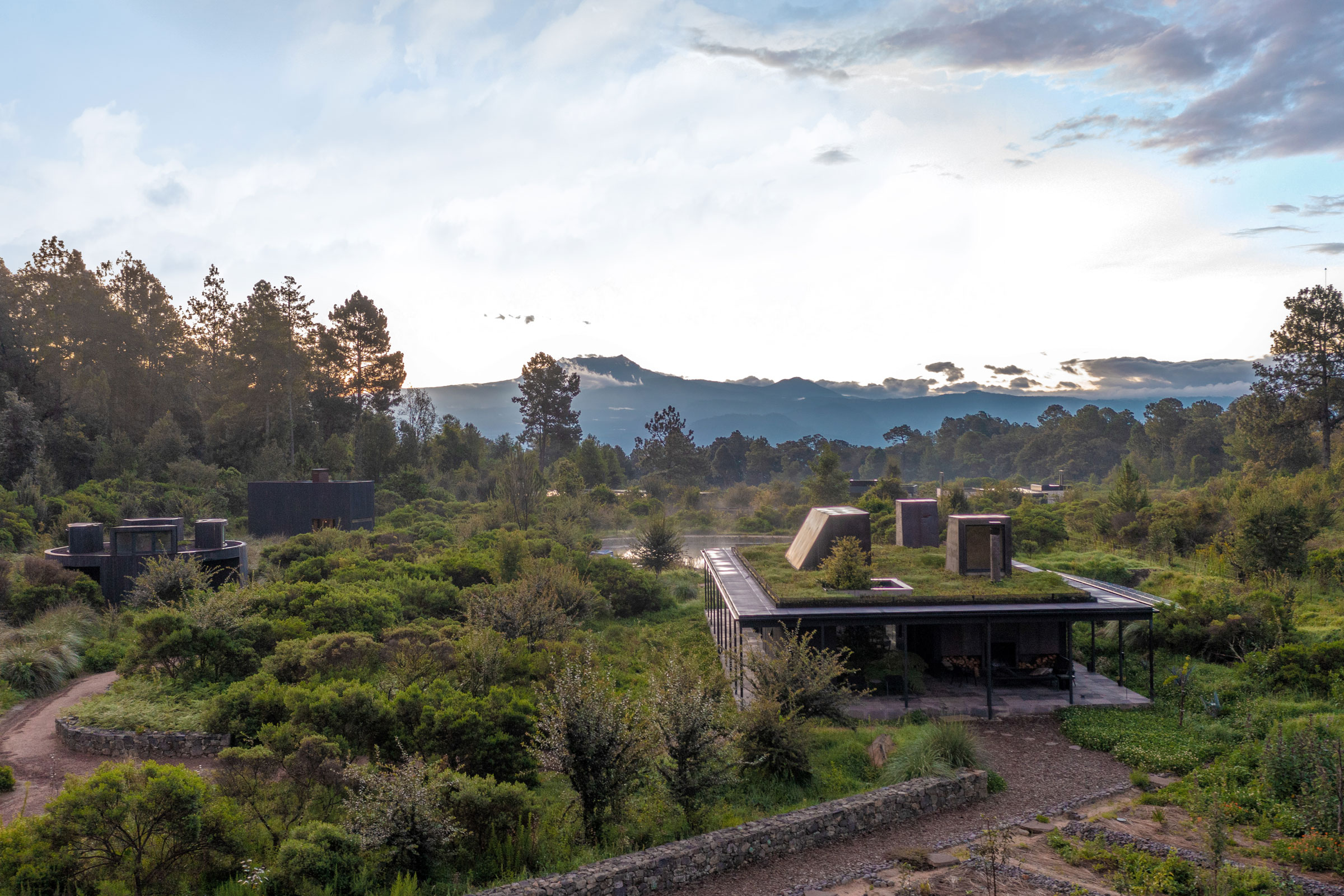
The Rain Harvest Home project is made up of three buildings that each collect rainwater to integrate with an above- and below-ground reservoir system. Photo by Jaime Navarro
Rainwater catchment systems are a great addition to your home if you’re looking to improve overall sustainability, as they help to conserve water and mitigate stormwater runoff. In the conventional sense, a simple rainwater barrel or container is sufficient for collecting rainwater if all you’re looking to use it for is irrigation or gardening—but you could also take it one step further by hooking up your rainwater catchment system to the household’s main plumbing system, to be used for washing clothes or filling toilet tanks.
You might decide to have an onsite rainwater treatment system installed, which opens up more possibilities for what that rainwater can be used for.
32. Clean Your Appliances Regularly
To ensure they are operating efficiently, take time to clean your appliances—particularly your refrigerator and dryer—regularly. Refrigerator coils, for example, accumulate dust and dirt over time, which reduces their ability to cool efficiently, forcing the appliance to draw more energy to keep your food cold.
Similarly, your dryer should be cleaned regularly to keep it running at peak efficiency—and we’re not just talking about the lint trap, but also the vent that gets rid of the warm, moist air. If you don’t clean your dryer’s lint trap after every load of laundry, it can become oversaturated with lint and reduce the machine’s drying ability by as much as 75%, resulting in the need for multiple cycles. Lint buildup also poses a potential fire hazard.
Your dryer’s vent doesn’t need to be cleaned after every load of laundry, as the lint trap catches most of the lint, but it should still be cleaned a few times each year to remove any lint that bypasses the trap.
33. Use Dryer Balls
And while we’re on the topic of dryer efficiency, you can improve the machine’s efficiency even further by using dryer balls. Typically made from sheep’s wool, dryer balls help separate damp laundry and prevent it from clumping together in the dryer, which ultimately helps improve air circulation and decreases drying times, thereby reducing energy consumption.
Dryer balls also aid in preventing wrinkles, static, and even help to soften clothes, negating the need for disposable, single-use dryer sheets.
34. Air-Dry Your Clothes
We’re not telling you to ditch your dryer altogether—rainy days do exist, after all—but opting to air-dry your clothes when possible can help your household save both energy and money.
On average dryers use approximately 3.3 kilowatt hours of energy per load of laundry and cost approximately $0.11 per kilowatt hour; the average clothesline holds between one to three loads of laundry depending on the length, which means you’ll save between $0.36 and $1.08 each time you fill the line.
If you switched entirely to air-drying, you could reduce your household’s carbon footprint by as much as 2,400 pounds per year, according to Green America—but even air-drying your clothes half the time is a great way to improve sustainability.
35. Practice Natural Landscaping & Xeriscaping

Located on the fringe of California’s Mojave Desert, this home designed by Jeremy Levine Design is surrounded by native, drought-resistant plants. Photo by Lance Gerber
You should also consider the area around your home. Traditionally residential landscaping prioritizes the cultivation of a single species of grass—such as zoysia, Kentucky bluegrass, ryegrass, fescue, etc.—that is periodically cut to achieve the picture-perfect lawn.
While this may look appealing, this type of landscaping is quite devastating for ecosystem biodiversity and soil health and contributes significantly to greenhouse gas emissions (through regular mowing) and water waste.
A more sustainable alternative to conventional landscaping is natural landscaping, or the practice of landscaping with plant species indigenous to your area. Natural landscaping requires less maintenance, uses less water (as the chosen species are already suited to the local climate and precipitation patterns), provides habitats and sustenance for birds and insects, and promotes the development of healthy, diverse soil microbiomes.
Similarly, natural xeriscaping is ideal for households in drought-prone areas, as it aims to significantly reduce—or completely eliminate—the need for irrigation by incorporating native plants that thrive with little to no supplemental water.
36. Switch to an Electric Lawn Mower

Electric mowers can help improve neighborhood air quality, reduce noise pollution, and allow homeowners to save money. Photo courtesy of Mean Green Products
Even yards that incorporate natural landscaping may need mowing from time to time; the only problem is traditional gas-powered mowers are major polluters and emit approximately 20 pounds of CO2 per gallon of gasoline burned. You can improve your neighborhood’s air quality and reduce your lawn maintenance emissions by switching to an electric mower, which has the added benefit of not contributing to noise pollution.
Ohio-based company Mean Green Mowers—owned by Generac Power Systems—is one of the leading producers of electric mowers, and though their products cost more up front, they help homeowners save money in the long run. “Because of the low price of electricity, roughly 15 cents a kilowatt hour on average across the US, it is a lot less than the price of gasoline,” Joe Ferris, product manager for Generac Power Systems, previously told gb&d. “There’s potentially a good amount of savings if you buy electric.”
Alternatively, if you only have a relatively small patch of grass that regularly needs to be mowed, ditch the lawn-mower altogether and learn how to use a scythe instead.
It may seem a bit outdated, but there’s a reason scythes have been used to cut grass for hundreds of years. Once you get the technique and rhythm down, the process is extremely efficient, quick, and doesn’t produce any emissions whatsoever. Just be sure to invest in a whetstone as well, as scythes only work well when they’re sharp.
37. Don’t Use Chemical Pesticides or Herbicides
No one wants fire ants in their yard or poison ivy creeping up the side of their house, but using chemical pesticides and herbicides to get rid of these unwanted guests isn’t the answer. Once sprayed these toxic compounds enter the soil and local waterways via rainwater runoff, where they then pollute ecosystems, poison wildlife, and kill off vital microbes.
To keep your household from contributing to these detrimental practices, look into using natural and nontoxic methods of keeping insects and weeds at bay. Not only does this help protect local ecosystems, it’s also safer for households with pets and children.
38. Plant Trees Strategically
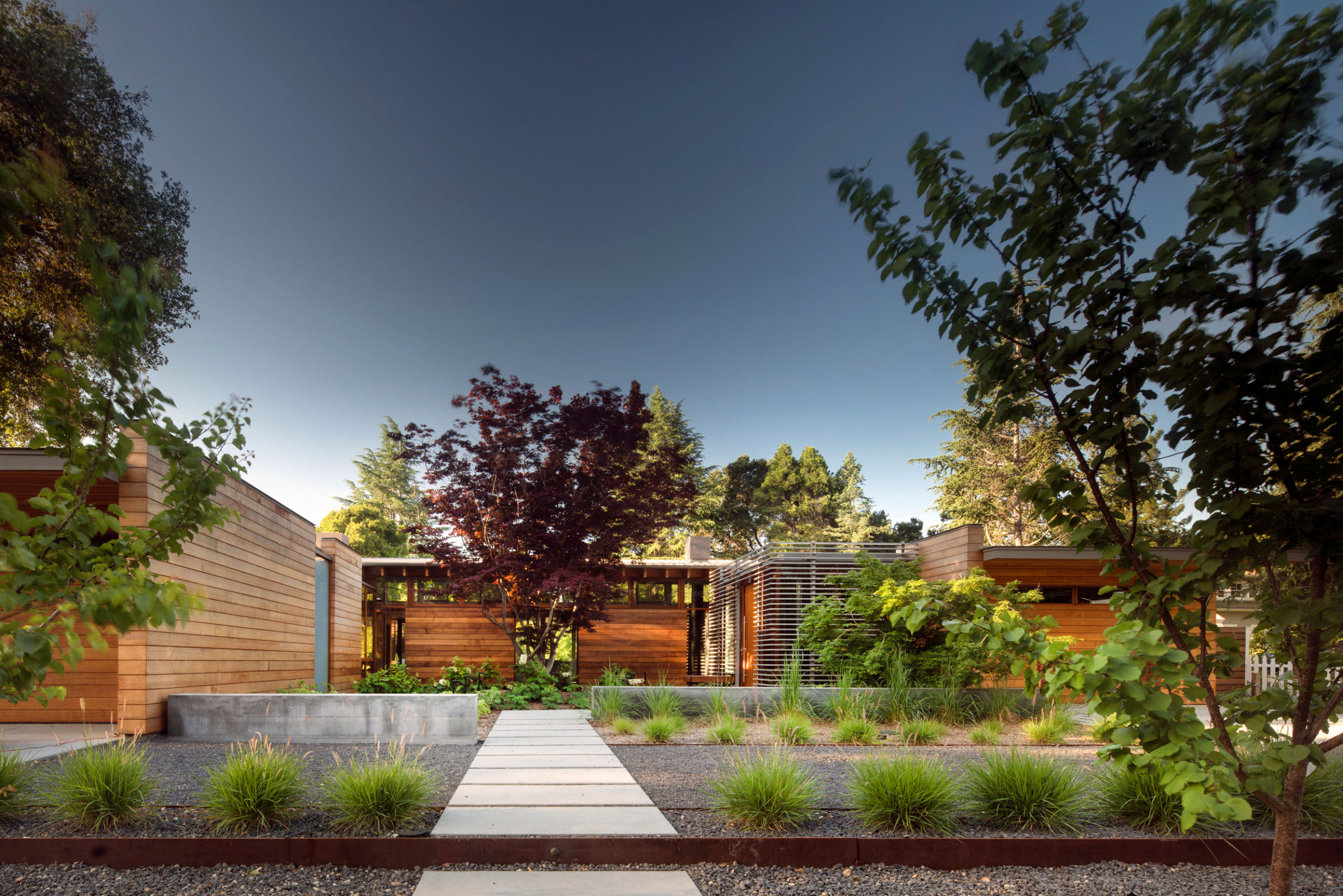
This Los Altos residence employs strategically placed trees for both shade and privacy. Photo by Nic Lehoux
While it’s not always possible to implement elements of passive solar design after a house is built, strategically planted trees can aid in providing shade and natural lighting during different times of the year.
Deciduous trees—or those trees which lose their leaves—for example, are most effective when planted along west- and east-facing windows. During the summer leafed-out trees provide shade and block solar heat admittance, reducing the need for air conditioning; in winter, bare, un-leafed trees no longer block the windows and allow for maximum solar energy admittance.
All in all, well-placed trees can save as much as 25% of the energy used to heat and cool the average household.
39. Compost Food Waste
It might seem arduous, but composting kitchen waste is actually fairly simple and can be done in a variety of ways. If you have outdoor space the easiest composting method is cold composting±or the process by which (mostly) anaerobic microorganisms ferment and break down waste, with minimal external involvement. All you really have to do is pile your organic material on the ground or in an open-sided bin in a partially shaded area of your yard.
It’s generally recommended you start with a layer of “brown” material (leaves, dry grass, small twigs, newspaper, cardboard, etc.) that measures roughly six inches deep and then start adding your nitrogen-rich “green” material (fruit and vegetable scraps, coffee grounds, eggshells, young weeds, fresh grass clippings, etc.). Any time green waste is added to the pile, add a layer of brown waste to cover it.
Cold compost does not need to be turned periodically, but you can use a pitchfork every once and a while to mix the layers together, if desired. Using this method you’ll have healthy, garden-ready compost in approximately six months to a year.
40. Start a Garden
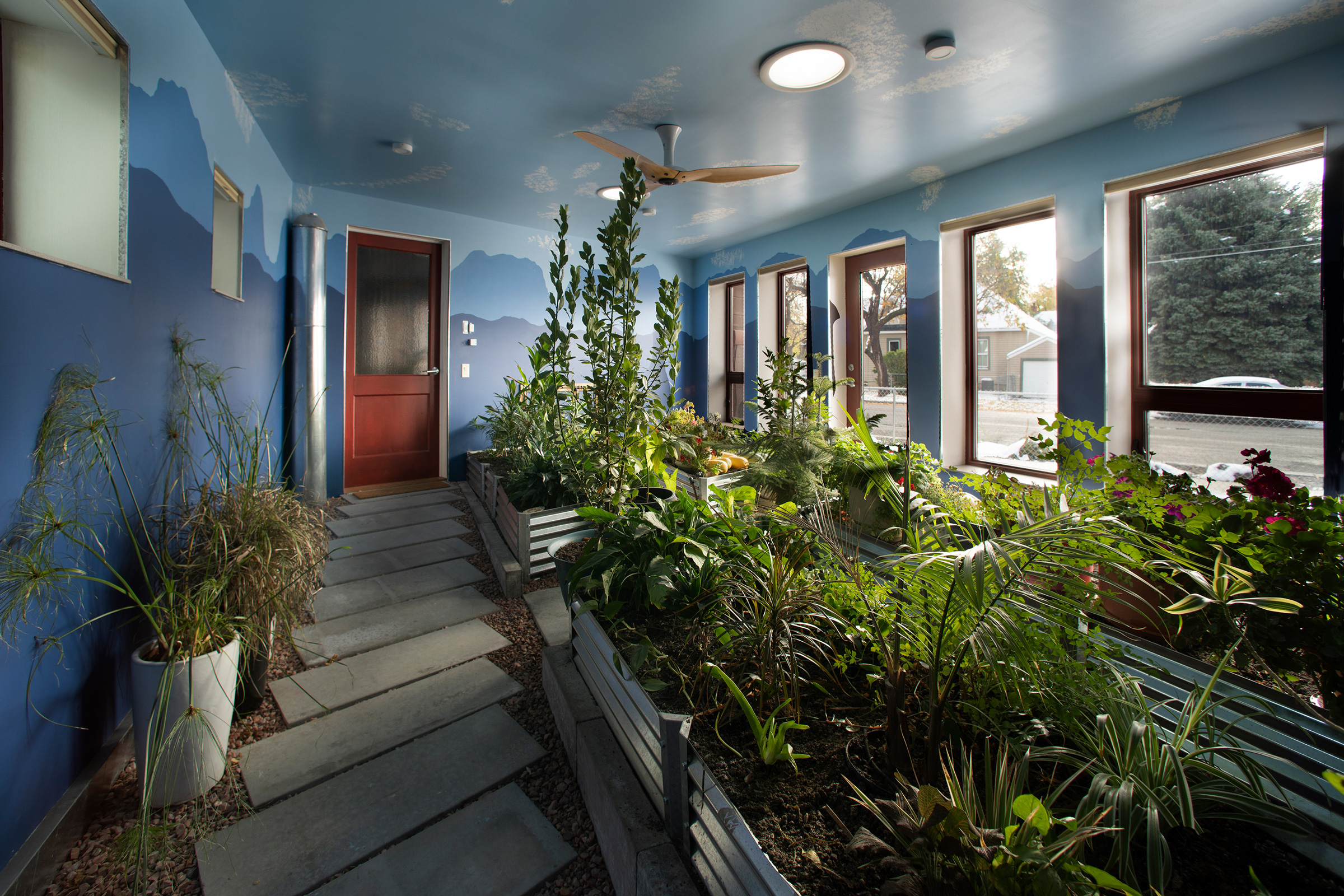
Even if you don’t have space outside, a garden can still be planted in raised beds or pots indoors. Photo by Clark Marten
If you’re already composting your household’s organic waste and don’t know what to do with it, consider starting a vegetable garden and growing a portion of the produce you eat. This helps reduce emissions associated with driving to the grocery store or having your produce delivered, while also reducing dependency on produce that has been transported long distances.
An effective garden doesn’t even need to take up a large portion of your yard—plants can even be grown in pots on a porch or balcony. If you’re new to gardening, start small with beginner-friendly plants like bell peppers, tomatoes, radishes, onions, and leafy greens.
41. Incorporate Houseplants

Beautiful interior plants, combined with the right décor and lighting, are the hallmarks of an inviting interior design. Photo courtesy of Ambius
That said, plants don’t need to be outdoors to improve your home’s overall sustainability. There’s also a range of benefits associated with incorporating plants into the home’s interior. Not only are plants good for improving mental health, they also aid in improving indoor air quality by absorbing carbon dioxide and expelling oxygen through photosynthesis.
Certain plants also have the ability to passively absorb other pollutants through their leaves and via their soil-and-root systems.
42. Use Green Cleaning Products
To avoid washing toxic chemicals into your home’s septic system or your city’s sewage system, switch to using green cleaning products that are free of harmful compounds. This goes for everything from the soap used to clean your dishes, the detergent you put in your washing machine, and the products you use to clean your household’s sinks, toilets, and showers.
Not only are these products better for the environment, they’re also less likely to cause lasting or debilitating harm if accidentally ingested or exposed to skin.
43. Invest in a Water Filter
If your house is connected to the city’s main line water supply, or even if you’re on well-water, chances are you’re not too keen on drinking from the tap but constantly buying and drinking from plastic water bottles isn’t great for the environment, either.
To circumvent both problems simultaneously, invest in a high-quality water filter. Depending on your preferences, you can buy a simple pitcher water filter—such as those offered by Brita—or opt for an under-sink water filter that connects directly to the plumbing.
Both options still produce some plastic waste via their replaceable filters, but drastically less so than buying water bottles outright—in fact, it’s estimated that a single six-month two-stage under-sink water filter prevents the use of 3,700 16.9 ounce plastic water bottles.
44. Stop Using Plastic Bags
It’s estimated that approximately 100 billion plastic bags are used every year in the US, with the average person using 365 bags annually. Despite their ability to be recycled, most plastic bags end up in landfills, where they will sit for thousands of years, slowly releasing microplastics into the air, soil, and water. For this reason eliminating household use of plastic bags is, for all intents and purposes, a necessity when it comes to sustainability.
You may have already done this if you live in a state like Vermont or California that has banned single-use plastic bags, but if you haven’t, make a conscious effort to avoid using plastic bags whenever possible. Investing in a few well-made canvas bags and keeping them in your vehicle is an easy way to avoid using plastic bags, be it at the grocery store or anywhere else you might buy something.
45. Move Away From Single-Use Disposables
While you’re at it, try to avoid buying and using single-use disposables altogether. Paper and plastic plates, plastic silverware, coffee cups, and zip-top bags are convenient, yes, but they make up a large portion of the waste disposed of in landfills each year. It’s estimated that more than 130 million metric tons of single-use plastics are thrown away each year.
As with plastic bags, these single-use disposables take a very long time to break down and release toxic microplastics as they degrade, contributing to water, soil, and air pollution. Making a conscious effort to avoid using single-use disposables wherever possible greatly reduces your household’s overall waste production.
46. Recycle
If it’s been said once, it’s been said a thousand times: Recycle household waste whenever possible. Cardboard, cartons, bottles, cans, and a variety of other plastic products can be recycled and brought to your local recycling center for collection and sorting. Brush up on what your city, county, municipality, etc. accepts at recycling facilities and clean out containers, bottles, and cans before dropping them off.
47. Shop Locally
To help reduce your household’s greenhouse gas emissions even further, try to do all of your shopping locally, especially when it comes to your groceries—or at the very least, your produce and animal products. Most large chain stores receive their products from all over the country, which means they produce a significant amount of emissions during the transportation process.
Many cities and towns—even highly urbanized ones—have farmer’s markets where local growers sell their produce and home-made products. Often these vendors adhere to more sustainable farming practices than industrial farms, meaning they are less likely to use harmful pesticides and preservatives.
Of course, shopping locally doesn’t just benefit the environment; you also help foster social sustainability by supporting local businesses and investing in the immediate community.
48. Avoid Buying Synthetic Textiles & Clothes
The clothes you buy and wear also contribute to the overall sustainability of your home, especially when it comes to the wastewater it produces. Synthetic textiles, for example, shed microplastics when washed—these microscopic bits of plastic then find their way into the plumbing, your septic tank, and eventually out into your property’s leach field, where they pollute the soil.
If your home is connected to your city’s sewage system, the microplastics shed from synthetic textiles have an even further reach, as they may not be fully removed during the treatment process at your city’s wastewater treatment plant before being released back into local waterways.
By refraining from buying synthetic textiles in favor of those made from natural materials derived from plants (e.g. cotton) or animals (e.g. wool), you ultimately improve the quality of your home’s wastewater.
49. Mend Damaged Clothes & Donate Those You Don’t Wear
On average 92 million tons of clothing ends up in landfills each year, while only a very small percentage—less than 1%—gets recycled into new fibers for new garments. To avoid contributing to those worrying statistics, don’t throw wearable clothes away and recycle those that have reached the end of their wearable lifespan.
Learning how to alter or mend minor holes, rips, and tears in clothing is an incredibly useful skill and allows your household to keep clothes for longer periods of time. Clothes that have been outgrown or are simply no longer worn should be donated if they are in good condition rather than being thrown away.
Garments that have been damaged beyond repair can still be repurposed for use as rags—in which case they reduce waste further by serving as sustainable alternatives to paper towels.
50. Purchase Sustainable Furniture
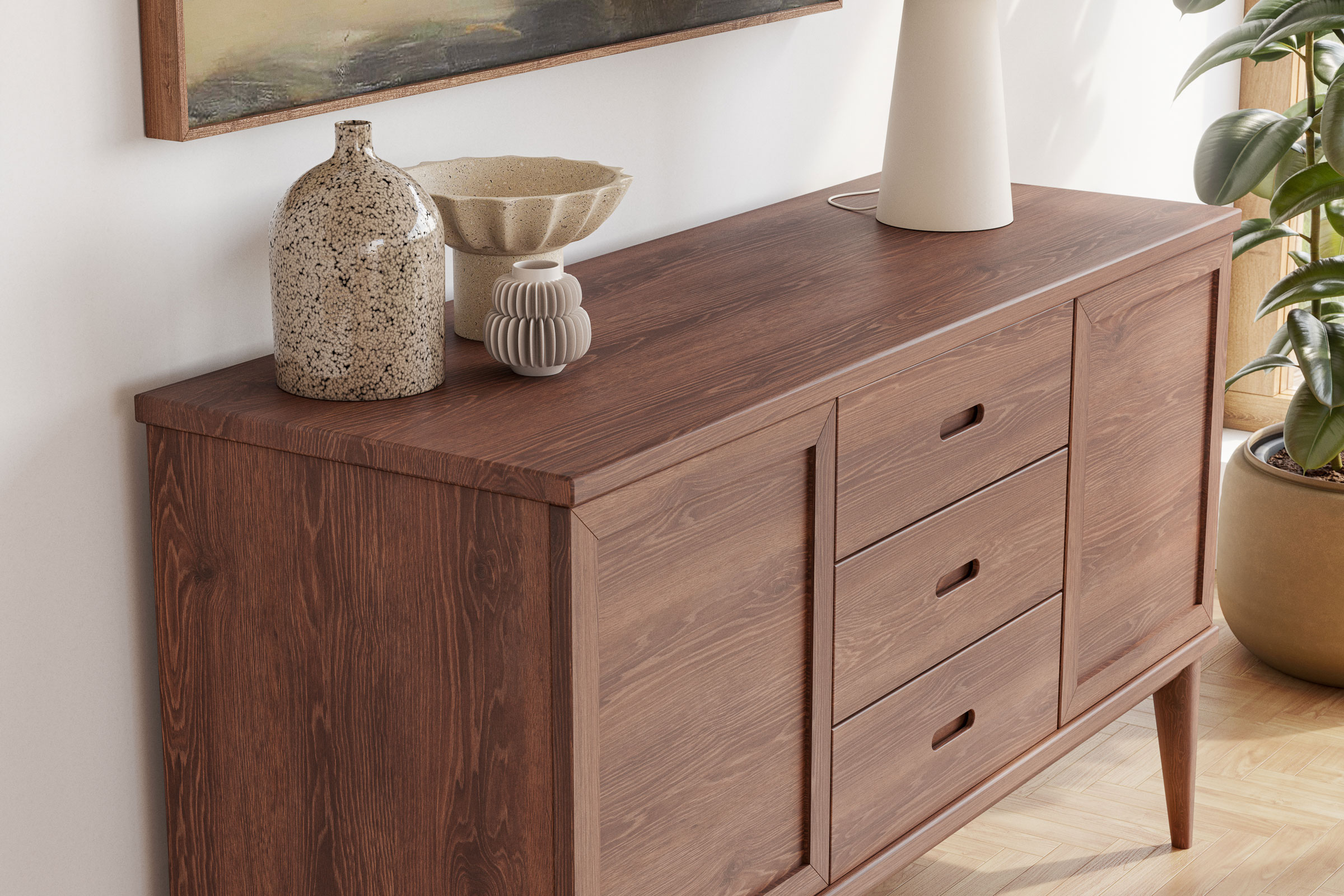
This credenza designed by Medley is made from FSC-certified wood and uses an all-natural beeswax finish to protect against water and heat damage. Photo courtesy of Medley
While the most sustainable furniture is made from recycled or upcycled materials, buying new furniture is sometimes unavoidable. That doesn’t mean, however, that it can’t be environmentally friendly.
Today there are many companies who offer eco-friendly, sustainable furniture options for home use, who use ethically sourced, renewable materials in the construction of their products. EcoBalanza, for example, is a Seattle-based furniture studio that produces all of their furniture by-hand from 100% nontoxic and sustainable materials.
“We are uncompromising in our use of the heist and purest quality natural, organic, sustainably harvested, and third-party-certified nontoxic materials in the world,” Aimee Robinson, founder and master designer at EcoBalanza, previously told gb&d. EcoBalanza boasts several collections and offers environmentally friendly, affordable ottomans, sofas, sectionals, chairs, and loveseats.
If you’re looking for other types of furniture, such as cabinets, desks, credenzas, and the like, you may also consider purchasing from Medley, a California-based company that constructs all of their products from FSC-certified walnut and maple. Many of their products are protected by either a beeswax or plant-based finish that emits zero VOCs and is both water- and heat-resistant.

